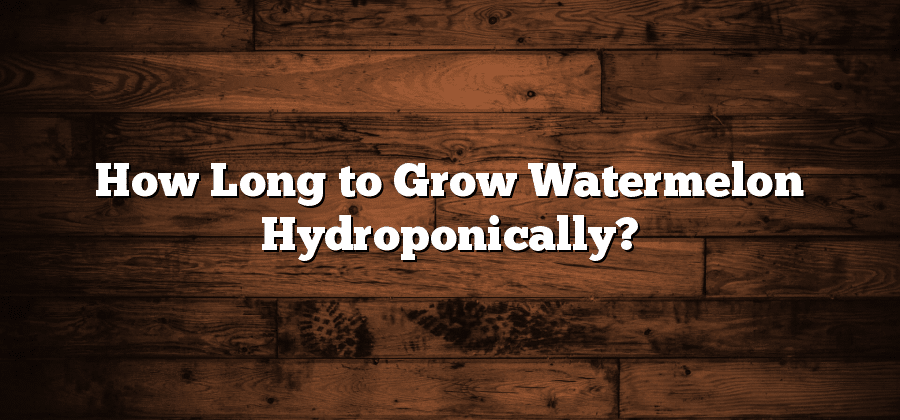Watermelon Growth in Hydroponic Systems
Watermelon growth in hydroponic systems is an exciting and innovative approach to cultivating this delicious and refreshing fruit. Hydroponics, a method of growing plants without soil, presents various advantages for watermelon production. One significant benefit is the ability to control nutrient levels and distribution, ensuring optimal growth and yield. In hydroponic systems, watermelon plants receive a precise balance of essential minerals and nutrients, leading to faster growth rates and potentially higher quality fruits.
Moreover, hydroponic systems offer better control over environmental factors such as temperature, humidity, and lighting. These conditions can be fine-tuned to mimic the ideal growing conditions for watermelons, promoting vigorous growth and increased productivity. The absence of soil in hydroponic systems also reduces the risk of soil-borne diseases, resulting in healthier plants with fewer pest issues. With the right combination of nutrient solutions and environmental control, hydroponic systems can provide a favorable environment for watermelon growth, enabling year-round cultivation and potentially higher yields than traditional soil cultivation methods.
Watermelon Varieties Suitable for Hydroponics
Watermelon, a popular summer fruit known for its sweet and refreshing taste, can be successfully grown in hydroponic systems. With the advancements in hydroponic technology, there is a wide range of watermelon varieties that are suitable for this growing method. These varieties have been specifically bred to thrive and produce excellent yields in hydroponic conditions.
One such variety is the “Sugar Baby,” a compact watermelon cultivar that is ideal for small-scale hydroponic setups. This variety has a short growing period, typically taking around 70 days from planting to harvest. Its small size makes it perfect for hydroponic containers and allows for efficient use of space. Additionally, “Sugar Baby” produces sweet and juicy fruits with a deep red flesh, making it a favorite among watermelon enthusiasts.
Another popular variety for hydroponics is the “Crimson Sweet.” This larger watermelon cultivar typically takes around 85 days to mature and offers a larger fruit size compared to “Sugar Baby.” The “Crimson Sweet” variety produces oval-shaped fruits with a firm and crisp texture. Its high sugar content and refreshing taste make it a sought-after choice for hydroponic growers.
These are just a few examples of watermelon varieties that have proven to be successful in hydroponic systems. When choosing a variety for hydroponic cultivation, it is essential to consider factors such as growth habit, fruit size, disease resistance, and taste preferences. By selecting the right watermelon variety, hydroponic growers can enjoy a bountiful harvest of delicious and nutritious fruits.
Optimal Conditions for Watermelon Growth
Watermelon plants, known for their juicy and refreshing fruit, can thrive in hydroponic systems if provided with the optimal conditions for growth. One crucial factor to consider is the nutrient solution. Watermelon plants have specific nutrient requirements, including nitrogen, phosphorus, and potassium, among others. Monitoring and adjusting the nutrient solution composition regularly is essential to ensure the plants receive the ideal balance of nutrients for healthy growth.
In addition to the nutrient solution, watermelon plants also require an appropriate temperature range and relative humidity. An optimal temperature for watermelon growth is typically between 75°F to 85°F (24°C to 29°C). At this temperature range, the plants can efficiently photosynthesize and metabolize the nutrients they absorb from the solution. Maintaining a relative humidity level of around 60% to 70% in the growing area helps prevent excessive transpiration and dehydration of the plants, ensuring their overall health and vitality.
Germination and Seedling Stage in Hydroponics
Watermelon seeds are often directly sown into hydroponic systems for germination and early seedling growth. Prior to sowing, it is important to select high-quality seeds from reputable sources to ensure optimal germination rates. The seeds should be cleaned, soaked in water for about 12-24 hours, and then transferred to a separate container with damp paper towels or some other germination medium. This process, known as pre-germination, helps to kickstart the germination process by providing the seeds with adequate moisture and creating an environment conducive to sprouting.
During the germination phase, the ideal temperature for watermelon seeds is around 80°F (27°C). Maintaining this temperature consistently is crucial for successful germination. Adequate lighting is also essential during this stage. Providing 16-18 hours of light per day using fluorescent or LED grow lights is recommended. As the seeds begin to germinate and the seedlings emerge, they should be carefully handled to avoid damage. Once the seedlings have developed their first true leaves, they can be transplanted into the hydroponic system, ensuring proper spacing to allow for their vegetative growth.
Vegetative Growth of Watermelon in Hydroponics
To promote vigorous vegetative growth of watermelon in hydroponics, it is essential to provide optimal growing conditions and proper care. Adequate lighting is crucial for the success of watermelon plants during this stage. Artificial light sources such as high-intensity discharge lamps or light-emitting diodes (LEDs) can be utilized to supplement natural sunlight, especially in indoor hydroponic setups.
In addition to lighting, maintaining proper temperature and humidity levels is vital for optimal vegetative growth. Watermelon plants thrive in warm temperatures, ideally between 70 to 85°F (21 to 29°C). It is important to monitor and control temperature fluctuations, as extreme heat or cold can negatively impact plant growth. Similarly, keeping the relative humidity between 60-80% helps in preventing stress-related issues and ensures healthy growth. Proper ventilation and airflow should also be ensured to prevent the buildup of excessive moisture and the possible development of diseases.
By providing the appropriate lighting, temperature, humidity, and airflow conditions, watermelon plants can flourish and achieve robust vegetative growth in hydroponic systems. However, it is crucial to note that other factors, such as nutrient solution management and regular pruning, should also be considered to achieve optimal plant growth and maximize yield. These aspects will be further explored in subsequent sections of this article.






